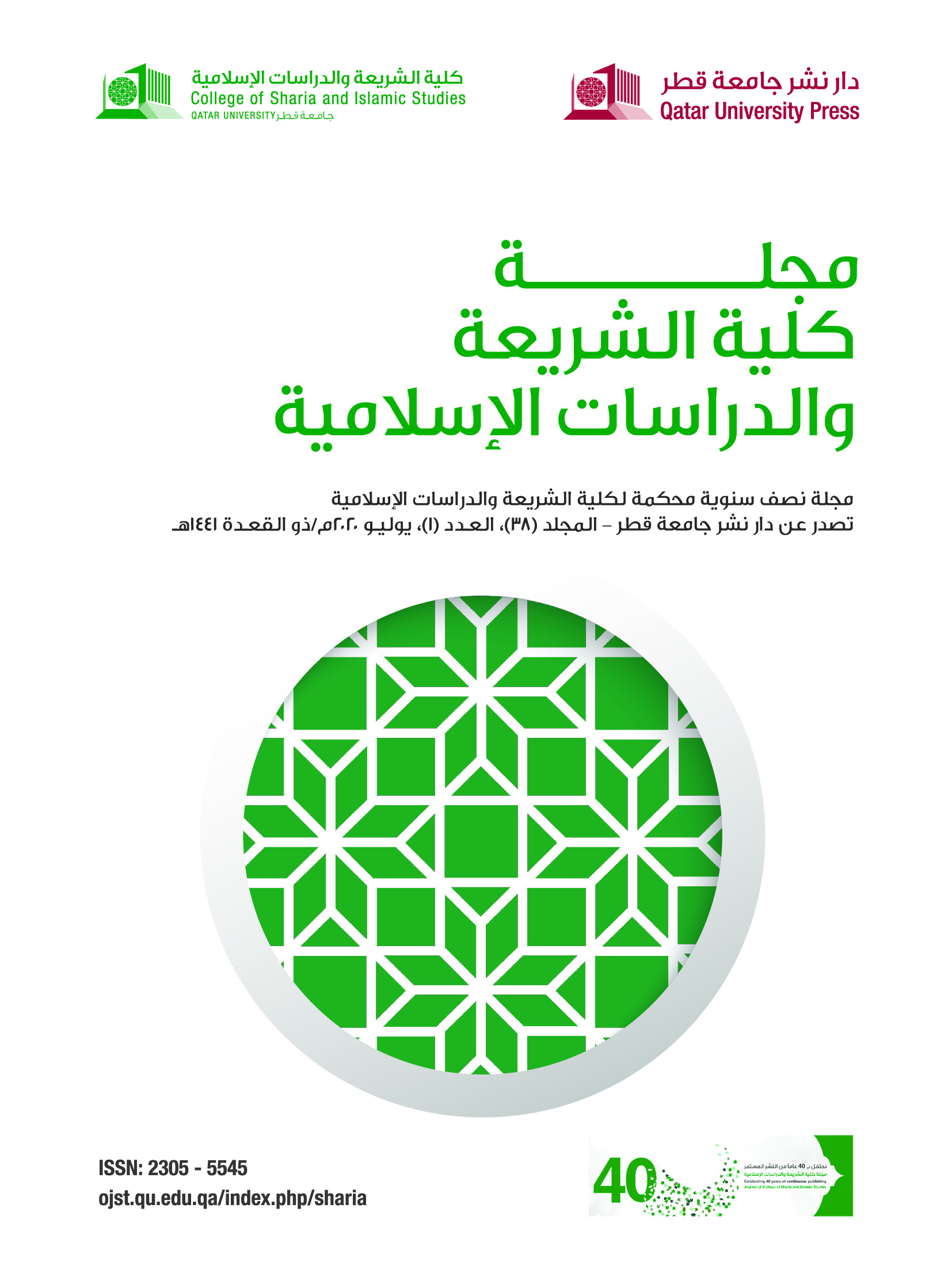النقد التاريخي وبعض النزعات المؤخرة في دراسة القرآن الكريم في الغرب: ملاحظات تأويلية
الملخص
أهداف البحث: يتناول هذا البحث جوانب الاختلاف بين منهج النقد التاريخي في دراسة القرآن الكريم وبين التأويل الإسلامي في فترة ما قبل الحداثة، ويستطلع سبل الاستفادة المتبادلة بين دراسة القرآن في جامعات الغرب وفي العالم الإسلامي.
منهج الدراسة: استخدمت هذه الدراسة المنهج التركيبي والمنهج المقارن.
النتائج: توصلت الدراسات الغربية المتأخرة إلى نتائج من شأنها أن تثير اهتمام الباحثين في العالم الإسلامي؛ ولو لم يكونوا على استعداد لتقبل المنهج التاريخي النقدي بشكل كلي. وقد انطوت هذه النتائج على مقارنة دقيقة بين القصص القرآني من جانب والتراث المسيحي واليهودي القديم من الجانب الآخر، وهو ما يتيح فهمًا أعمق لخصوصية التعاليم القرآنية على هدي من خلفية فكرية معاصرة. أضف إلى ذلك ما شهدته العقود القليلة الماضية من اهتمام كبير بالبنية الأدبية والبلاغية للقرآن الكريم في أوساط الباحثين الغربيين، هذا مع زيادة الوعي بإمكانية استفادة التحليل الأدبي والبلاغي للقرآن الكريم من مؤلفات علوم القرآن الإسلامية، حتى ولو طُبق هذا التحليل من منظور نقدي تاريخي.
المقاييس
##plugins.themes.bootstrap3.article.details##
منهج النقد التاريخيدراسة القرآن الكريم في الغربتأويليالتراث المسيحي واليهودي القديمالتحليل الأدبي والبلاغي للقرآن الكريم
• Bannister, Andrew G. An Oral-Formulaic Study of the Qur’an. Lanham: Lexington Books, 2014.
• Davidson, Herbert A. Moses Maimonides: The Man and His Works. Oxford: Oxford University Press, 2005.
• Farrin, Raymond. Structure and Qur’anic Interpretation: A Study of Symmetry and Coherence in Islam’s Holy Text. Ashland: White Cloud Press, 2014.
• Griffith, Sidney. “Christian Lore and the Arabic Qurʾān: The Companions of the Cave in Sūrat al-Kahf and in Syriac Christian Tradition.” In The Qurʾān in its Historical Context, edited by Gabriel S. Reynolds, 109–137. Abingdon: Routledge, 2008.
• Iṣlāḥī, Amīn Aḥsan. Tadabbur-e Qurʾān: Pondering over the Qurʾān. Vols. 1 and 2. Translated by Mohammad Saleem Kayani. Islamic Book Trust: Petaling Jaya, 2007 and 2015.
• Mir, Mustansir. Coherence in the Qurʾān: A Study of Iṣlāḥī’s Concept of Naẓm in Tadabbur-i Qurʾān, Indianapolis: American Trust Publications, 1986.
• Mir, Mustansir. “The Sūra as a Unity: A Twentieth Century Development in Qurʾān Exegesis.” In Approaches to the Qurʾān, edited by G. R. Hawting and Abdul-Kader A. Shareef, 211–224. London: Routledge, 1993.
• Mir, Mustansir. “Continuity, Context, and Coherence in the Qurʾān: A Brief Review of the Idea of Naẓm in Tafsīr Literature.” Al-Bayān 11, no. 2 (2013): 15–29.
• Neuwirth, Angelika. Studien zur Komposition der mekkanischen Suren. Second edition. Berlin: De Gruyter, 2007.
• al-Rāzī, Fakhr al-Dīn. Tafsīr al-Fakhr al-Rāzī al-mushtahir bi-l-Tafsīr al-kabīr wa-Mafātīḥ al-ghayb. 32 vols., (in Arabic), Beirut: Dār al-Fikr, 1981/1401 AH.
• Reda, Nevin. The al-Baqara Crescendo: Understanding the Qurʾan’s Style, Narrative Structure, and Running Themes. Montreal: McGill-Queen’s University Press, 2017.
• Robinson, Neal. Discovering the Qur’an: A Contemporary Approach to a Veiled Text. Second edition. London: SCM Press, 2003.
• Salih, Walid A. In Defense of the Bible: A Critical Edition and an Introduction to al-Biqāʿī’s Bible Treatise. Leiden: Brill, 2008.
• Sinai, Nicolai. “Historical-Critical Readings of Abrahamic Scriptures.” In The Oxford Handbook of Abrahamic Religions, edited by Adam Silverstein and Guy Stroumsa, 209–225. Oxford: Oxford University Press, 2015.
• Sinai, Nicolai. “Gottes Wort und menschliche Deutung: Überlegungen zum Verhältnis von islamischer Schriftauslegung und historischer Kritik.” In Deutung des Wortes – Deutung der Welt im Gespräch zwischen Islam und Christentum, edited by Andreas Feldtkeller and Notger Slenczka, 151–171. Leipzig: Evangelische Verlagsanstalt, 2015.
• Sinai, Nicolai. “Reading Sūrat al-Anʿām with Muḥammad Rashīd Riḍā and Sayyid Quṭb.” In Reclaiming Islamic Tradition: Modern Interpretations of the Classical Heritage, edited by Elisabeth Kendall and Ahmad Khan, 136–159. Edinburgh: Edinburgh University Press, 2016.
• Sinai, Nicolai. The Qur’an: A Historical-Critical Introduction. Edinburgh: Edinburgh University Press, 2017.
• Sinai, Nicolai. “Two Types of Inner-Qurʾānic Interpretation.” In Exegetical Crossroads: Understanding Scripture in Judaism, Christianity and Islam in the Pre-Modern Orient, edited by Georges Tamer et al., 253–288. Berlin: De Gruyter, 2018.
• Sinai, Nicolai. “Pharaoh’s Submission to God in the Qur’an and in Rabbinic Literature: A Case Study in Qur’anic Intertextuality.” In The Qur’an’s Reformation of Judaism and Christianity, edited by Holger Zellentin, 235–260. Abingdon: Routledge, 2019.
• al-Suyūṭī, Jalāl al-Dīn. Al-Itqān fī ʿulūm al-Qurʾān. (in Arabic), Medina: Majmaʿ al-Malik Fahd li-Ṭibāʿat al-Muṣḥaf al-Sharīf, 1426 AH.
• al-Suyūṭī, Jalāl al-Dīn. Marāṣid al-maṭāliʿ fī tanāsub al-maqāṭiʿ wa-l-maṭāliʿ. (in Arabic), Riyadh: Maktabat Dār al-Minhāj, 1426 AH.
• Witztum, Joseph. “Variant Traditions, Relative Chronology, and the Study of Intra-Quranic Parallels.” In Islamic Cultures, Islamic Contexts: Essays in Honor of Professor Patricia Crone, edited by Behnam Sadeghi, Asad Q. Ahmed, Adam Silverstein, and Robert Hoyland, 1–50. Leiden: Brill, 2014.
• Zahniser, A. H. Mathias. “Sūra as Guidance and Exhortation: The Composition of Sūrat al-Nisāʾ.” In Humanism, Culture, and Language in the Near East: Studies in Honor of Georg Krotkoff, edited by Asma Afsaruddin and A. H. Mathias Zahniser, 71–85. Winona Lake: Eisenbrauns, 1997.
• Zahniser, A. H. Mathias. “Major Transitions and Thematic Borders in Two Long Sūras: al-Baqara and al-Nisāʾ.” In Literary Structures of Religious Meaning in the Qurʾān, edited by Issa J. Boullata, 26–55. Richmond: Curzon, 2000.


